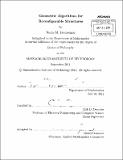| dc.contributor.advisor | Erik D. Demaine. | en_US |
| dc.contributor.author | Benbernou, Nadia M | en_US |
| dc.contributor.other | Massachusetts Institute of Technology. Dept. of Mathematics. | en_US |
| dc.date.accessioned | 2012-01-12T19:31:00Z | |
| dc.date.available | 2012-01-12T19:31:00Z | |
| dc.date.copyright | 2011 | en_US |
| dc.date.issued | 2011 | en_US |
| dc.identifier.uri | http://hdl.handle.net/1721.1/68480 | |
| dc.description | Thesis (Ph. D.)--Massachusetts Institute of Technology, Dept. of Mathematics, 2011. | en_US |
| dc.description | Cataloged from PDF version of thesis. | en_US |
| dc.description | Includes bibliographical references (p. 159-163). | en_US |
| dc.description.abstract | In this thesis, we study three problems related to geometric algorithms of reconfigurable structures. In the first problem, strip folding, we present two universal hinge patterns for a strip of material that enable the folding of any integral orthogonal polyhedron of only a constant factor smaller surface area, and using only a constant number of layers at any point. These geometric results offer a new way to build programmable matter that is substantially more efficient than what is possible with a square N x N sheet of material, which can achieve all integral orthogonal shapes only of surface area O(N) and may use E(N 2) layers at one point [BDDO1O]. To achieve these results, we develop new approximation algorithms for milling the surface of an integral orthogonal polyhedron of genus 0, which simultaneously give a 2-approximation in tour length and an 8/3-approximation in the number of turns. Both length and turns consume area when folding strip, so we build on previous approximation algorithms for these two objectives from 2D milling. In the second problem, maxspan, the goal is to maximize the distance between the endpoints of a fixed-angle chain. We prove a necessary and sufficient condition for characterizing maxspan configurations. The condition states that a fixed-angle chain is in maxspan configuration if and only if the configuration is line-piercing (that is, the line through each of the links intersects the line segment through the endpoints of the chain in the natural order). We call this the Line-Piercing Theorem. The Line-Piercing Theorem was originally proved by [BSO8] using Morse-Bott theory and Mayer-Vietoris sequences, but we give an elementary proof based on purely geometric arguments. The Line-Piercing Theorem also leads to efficient algorithms for computing the maxspan of fixed-angle chains. In the third problem, efficient reconfiguration of pivoting tiles, we present an algorithmic framework for reconfiguring a modular robot consisting of identical 2D tiles, where the basic move is to pivot one tile around another at a shared vertex. The robot must remain connected and avoid collisions throughout all moves. For square tiles, and hexagonal tiles on either a triangular or hexagonal lattice, we obtain optimal O(n 2)-move reconfiguration algorithms. In particular, we give the first proofs of universal reconfigurability for the first two cases, and generalize a previous result for the third case. We also consider a model analyzed by Dumitrescu and Pach [DP06] where tiles slide instead of pivot (making it easier to avoid collisions), and obtain an optimal O(n2)-move reconfiguration algorithm, improving their 0(n') bound. | en_US |
| dc.description.statementofresponsibility | by Nadia M. Benbernou. | en_US |
| dc.format.extent | 163 p. | en_US |
| dc.language.iso | eng | en_US |
| dc.publisher | Massachusetts Institute of Technology | en_US |
| dc.rights | M.I.T. theses are protected by
copyright. They may be viewed from this source for any purpose, but
reproduction or distribution in any format is prohibited without written
permission. See provided URL for inquiries about permission. | en_US |
| dc.rights.uri | http://dspace.mit.edu/handle/1721.1/7582 | en_US |
| dc.subject | Mathematics. | en_US |
| dc.title | Geometric algorithms for reconfigurable structures | en_US |
| dc.type | Thesis | en_US |
| dc.description.degree | Ph.D. | en_US |
| dc.contributor.department | Massachusetts Institute of Technology. Department of Mathematics | |
| dc.identifier.oclc | 769951303 | en_US |
